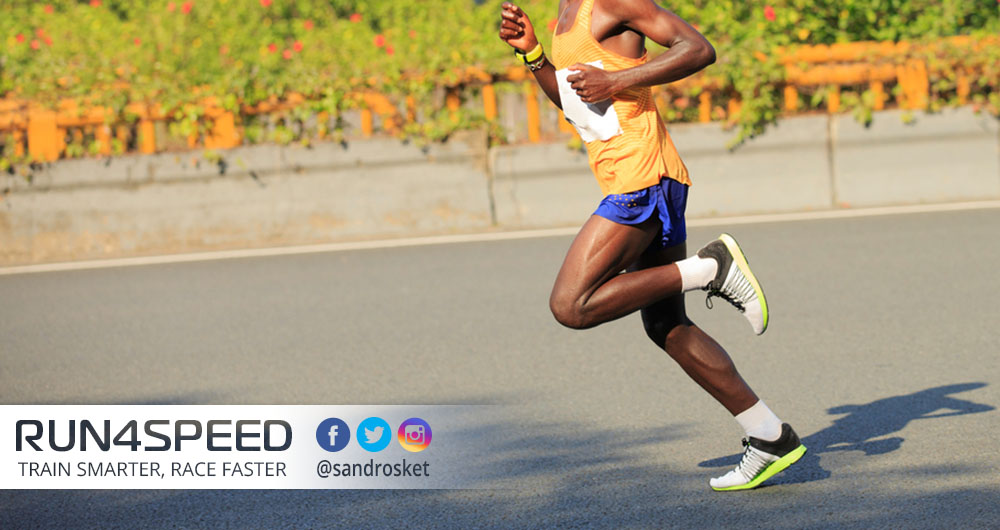3 Potent VO2max Workouts for Competitive Runners
VO2max workouts are the hardest training sessions to execute and recover from. I myself experience a thrill – sometimes even fear – right before these intense intervals, not unlike stepping into the ring against a superior opponent. This mental battle is against the ‘will of your body’, which seeks an easy way out. But pushing through that comfort zone is exactly what triggers the most potent adaptations, and ultimately, separates you from mid-pack runners.
“If you don’t do VO2max workouts then you’re not a competitive runner.”
VO2max Training in Theory
Aerobic capacity (VO2max) is 1 of 5 factors for fast race results. The other 4 are aerobic endurance, lactate threshold, raw speed, and running economy. They, too, play a vital role in competitive running. But VO2max is your primary limiter for running speed from the 5K to the marathon by a whopping 80%. In other words, an average VO2max equals an average race result despite all other factors being well-developed.
VO2max is measured by how much oxygen your skeletal muscles can extract per kilo body weight per minute. The key characteristics that improve aerobic capacity are the stroke volume of your heart, a high blood plasma volume with an abundance of red blood cells, the number and size of mitochondria within your running muscles, and high aerobic enzyme levels to facilitate aerobic metabolism.
All these adaptations are enhanced with a variety of workout types, such as easy runs, steady-state runs, long runs, tempo runs, and intervals. Therefore, it is not only the VO2max intervals that improve VO2max. They are simply called that way because they have the most pronounced effect on VO2max. But it would be wrong to assume that a diet of VO2max intervals is all it takes to achieve a higher aerobic capacity. Your overall weekly mileage matters too. If you increase your mileage from 20 – 30 miles to 40- 50, you will likely experience a significant rise in your VO2max, which can be done with 4 to 6 days of running per week. Beyond 50 miles further improvements are incremental.
True VO2max pace (100% of VO2max) is 2K to 3K race pace, which is a one-time 6 – 9 min all-out effort. But for training purposes, intensities as low as 10K race pace (~90% of VO2max) are being used. The duration of each interval should be 2 – 6 min long, depending on the intensity being applied, all of which are above your lactate threshold. Note that intensities in excess of 100% of VO2max (1500m race pace and faster) do not lead to additional benefits for your aerobic capacity.
VO2max Workouts in Practice
Before we delve into the specifics VO2max intervals, here’s an essential warm-up and cool-down routine that precedes the intervals. At the very minimum, start with a 10-minute warm-up jog, followed by dynamic stretches or form drills and 1 mile (1 – 2 km) of easy running with 4x 100m accelerations at 3K to 1500m pace. Not only will this reduce your risk of injury, but you will also perform better during the main set after a proper warm-up. For your cool-down, another mile of easy running should suffice to return to homeostasis. That gets your muscles ready for the next workout on another day and reduces your cortisol levels.
800s at 3K pace: This intense workout is excellent for improving your running economy and VO2max alike. The anaerobic contribution is a manageable 10 – 15%, therefore it won’t negatively affect your aerobic enzyme levels. Do 4 – 6x 800m at 3K race pace with a work to rest ratio of 1:1. 3K-pace serves as direct speed support for the 5K-paced intervals. Hence, these shorter but more intense intervals should precede longer, more race-specific VO2max training. Use a performance chart if you are unsure about the exact intensity.
1000s at 5K pace: This is a classic VO2max workout as it is an ideal combination of intensity and interval duration. As with all VO2max workouts, this is likely to be the hardest running session of your week so make sure it’s sandwiched between easy runs or rest days. Aim for no less than 4 – 5x 1000m at 5K-pace with a work-to-rest ratio of 1:1 or 1:2/3. If you’re training for a 5K then the interval length can be extended to 1200m or rest intervals slightly shortened to make this workout more race-specific. In any case, let your heart rate drop to about 120bpm. If you’re training for a 10K then 5K-pace also serves as direct speed support.
1600s at 10K pace: Your heart needs about a minute from the start of each interval to match the required intensity level. Therefore these longer intervals accumulate more time at target heart rate than shorter ones. This is also a great workout to improve lactate tolerance as well as the running economy for 10K events. A common workout 3 – 4x 1600m at 10K-pace with a work-to-rest ratio of 1:1/2. Faster runners can extend the interval length to 2000m, especially in the final weeks preparing for a 10K. For 5K runners, 10K-paced intervals serve as direct endurance support.
In summary: VO2max workouts are not the only component for faster race results. But they have the highest impact on your speed across all distances from the 5K to the marathon. 5K and 10K runners can perform the above-mentioned VO2max intervals up to twice a week in the final weeks before race day. For half-marathon and marathon runners a weekly VO2max session suffices as steady-state runs and lactate threshold runs are more race-specific for these longer events.
5K Plans | 10K Plans | HM Plans
Sandro Sket, CSCS
Share this article


